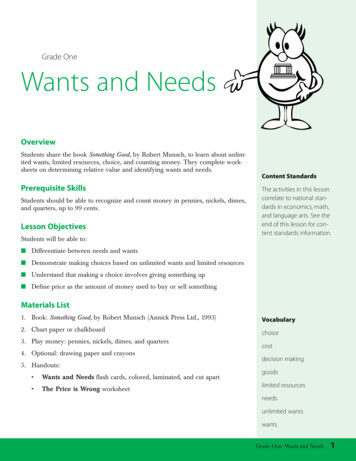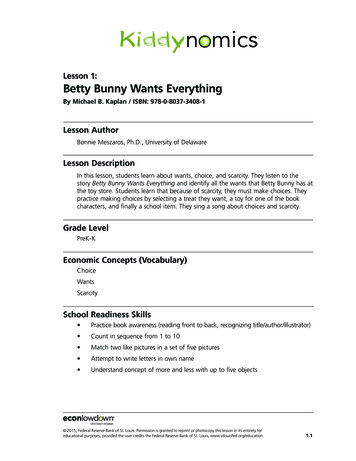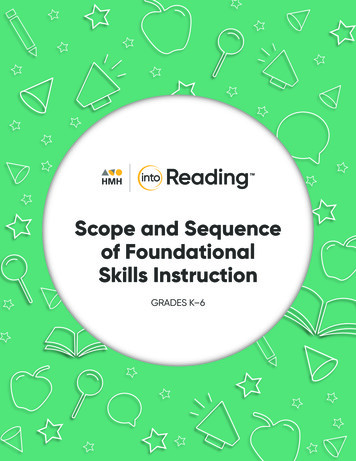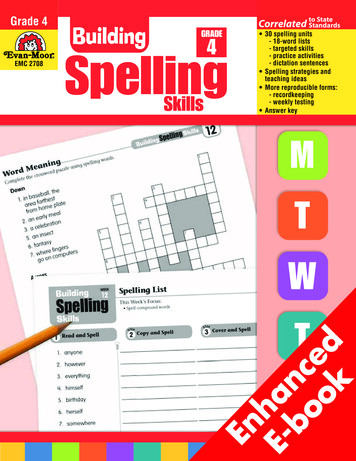
Transcription
Grade OneWants and NeedsOverviewStudents share the book Something Good, by Robert Munsch, to learn about unlimited wants, limited resources, choice, and counting money. They complete worksheets on determining relative value and identifying wants and needs.Content StandardsPrerequisite SkillsStudents should be able to recognize and count money in pennies, nickels, dimes,and quarters, up to 99 cents.Lesson ObjectivesStudents will be able to:The activities in this lessoncorrelate to national standards in economics, math,and language arts. See theend of this lesson for content standards information. Differentiate between needs and wants Demonstrate making choices based on unlimited wants and limited resources Understand that making a choice involves giving something up Define price as the amount of money used to buy or sell somethingMaterials List1. Book: Something Good, by Robert Munsch (Annick Press Ltd., 1993)Vocabulary2. Chart paper or chalkboardchoice3. Play money: pennies, nickels, dimes, and quarters4. Optional: drawing paper and crayonscostdecision making5. Handouts: Wants and Needs flash cards, colored, laminated, and cut apart The Price is Wrong worksheetgoodslimited resourcesneedsunlimited wantswantsGrade One: Wants and Needs1
Large-Group ActivityMaterials Book: Something Good Chart paper or chalkboard, divided into two sections by a line down the centerof the writing area Handout: Wants and Needs flash cards, colored, laminated, and cut apart Optional: drawing paper and crayons1. Gather students in the reading corner to share the book Something Good. Say:Have you ever gone grocery shopping with someone? What kinds ofthings do they sell in a grocery store that you like? Allow several students to suggest favorite foods or other items found in grocery stores.Today we’re going to be talking about the things we want, and howwe can’t always get everything we want. I’m going to read a bookabout a family that takes a trip to the grocery store. It’s calledSomething Good, by Robert Munsch. The pictures in the story weremade by Michael Martchenko.This book is especially fun because Mr. Munsch writes about hisown family, and Mr. Martchenko’s drawings look just like them! Ifyour copy of the book includes a picture of Robert Munsch, show studentshis photograph along with the cover illustration so they can see the resemblance.The little girl in this story, Tyya (pronounced tie-ya), is unhappybecause her dad never buys anything “good” at the grocery store.Let’s see what happens. Read the book aloud to the class. Be sure to allow the entire class time tosee each picture.2. Briefly discuss the book with the class. Tyya said that sometimes her dad doesn’t buy “good” food. Whatkind of things did her dad buy?He gets bread, eggs, milk, cheese, and spinach. What did Tyya consider “good” food?Ice cream, cookies, chocolate bars, and ginger ale. What was funny about the foods Tyya tried to get her father to buy?She put hundreds of things in her cart: 100 boxes of ice cream and 300chocolate bars. What did her dad call the food she picked out?He called it “sugary junk.” Why do you think some of the people thought Tyya was a doll?Her father told her to stand in one place and not move. She did such agood job, she looked like a doll.2Personal Finance for Kids
How much did the lady who worked at the store decide to sell Tyyafor?She decided to “sell” her for 29.95. Why do you think Tyya’s dad paid 29.95 to buy Tyya?He wanted her to know that he loved her and thought she was worth themoney to him.3. Discuss today’s concepts: unlimited wants, limited resources, choice and needsversus wants. Unlimited Wants and Limited ResourcesSay:Do you agree with Tyya’s idea of “good” food? What are some ofyour favorite foods? Write some of the students’ choices on the board, listing them in the left-hand section of the two-part writing area.Do any of you agree with the food Tyya’s dad picked out? Howmany of you like bread? Have students raise their hands as you runthrough the kinds of foods the father bought: eggs, milk, cheese, andspinach.Everybody has a different idea of what “good” food is, but we canagree that we all want good food, no matter what we think is good.The things that we want that we have to pay for are called wants.Write “wants” on the board above the list of foods, and underline it.The problem is, we want a LOT of things. Look at how much Tyyawanted. Show the picture of Tyya’s shopping cart overflowing with icecream or chocolate bars again.If someone told you that you could have all the ice cream youwanted, would you pick out one thing, or would you fill your cartlike Tyya did?Because people always want more and more and more, we say thatwe have unlimited wants. Write the word “unlimited” beside “wants” onthe board.The word “unlimited” means there is no end. People never stopwanting. Tyya’s father probably wanted to buy lots more stuff in thestore, too. Why do you think he didn’t fill his shopping cart with 100loaves of bread and 300 dozen eggs? Allow students to speculate. Somepossible answers might be: Tyya’s father didn’t have enough money for that much food. Tyya’s family can’t eat that much food before it goes bad.On the right-hand section of the board, list “time” and “money.” Say:Even though people have unlimited wants, they can’t have everything. There are lots of reasons why we can’t have everything wewant, but today we’re going to talk about one reason: money.A resource is something that helps you get the things you want.Point to the list in the “wants” section.If no one mentions money,ask if they think Tyya’s fathercould pay for hundreds offood items.Grade One: Wants and Needs3
The problem with resources is that they aren’t “unlimited” likewants. What does “unlimited” mean again?It means there is no end to them.What do you think we call something that DOES have an end?Students should guess “limited.”If necessary, cover up theprefix “un” in front of theword “unlimited” on theboard.There is an end to the amount of money people have. Becausemoney has a limit, we call it a limited resource. Write the word“limited” above the word “resources” on the board.Do you think Tyya’s father had enough money to buy all the icecream and chocolate bars AND all the other groceries his familyneeded?No.So we can say that Tyya and her family had unlimited wants—meaning if they could, they would have bought hundreds and hundreds ofthings in the store. But they also had limited resources—meaningthere wasn’t enough money to buy all the things they wanted. Choice and Needs versus WantsTyya’s father had to think about his limited resources. Then he hadto think about what his family needed. Do you think his familyneeded 100 boxes of ice cream and 300 chocolate bars?No, they wanted them, but they didn’t need them.You may need to substituteother vegetables for thespinach to get students toaccept the need for healthyfood!Do you think they needed bread, eggs, milk, cheese, and spinach?Encourage students to discuss this thoroughly. Avoid a lengthy discussion ofnutrition, but do stress the need for good food versus the want of junk food.When you don’t have enough resources to get everything you want,you sometimes have to make a choice. Write the word “choice” in largeletters below both lists on the chart paper.Making a choice means to decide just what you will use yourresources on. Spend your resources on the things you need first, andif there is any left over, then get some of the things you want.Tyya’s father was doing that in the story: he was choosing the groceries that his family needed. Remember what he called the icecream and chocolate bars?He called them “sugary junk.”He decided his family didn’t need sugary junk, so he wouldn’t spendhis money on those things.Why did he spend his money buying Tyya? Allow any answers.Students may suggest that her father needed Tyya, which is a nice ending tothis lesson.4. Wants and Needs flash cards, colored, laminated, and cut apartNow let's practice identifying wants and needs. I've got a set of flashcards. When I hold one up, tell me if the picture on the card issomething that you need—you have to have it to live—or if it is a4Personal Finance for Kids
want—something that you would like to have, but you can live without it.Shuffle the Wants and Needs flashcards and hold them up one at a time.Allow students to call out the answers. If students disagree on an item, stopand discuss it with the class. Make sure they understand the differencebetween goods that they must have to survive and those that they don'treally need.Optional: You might ask students to draw a picture of a want they wouldlike to have while you work with individual groups in the following smallgroup activities.Small-Group Activity One: PriceIf the group is large youmay need to walk around tomake sure everyone seesthe flash cards.Concepts TaughtPrice and Counting MoneyMaterials Four medium-sized grocery sacks Toy foods (or pictures of foods cut from magazines and laminated to coloredpaper): four dairy items, four meat items, four vegetable items, and four “junkfood” items like cakes and candies Price tags or blank stickers Play money The Price is Wrong worksheet1. Set up the activity ahead of time. Assign prices to each of the toy food items (or pictures). Each item shouldbe labeled less than a dollar, and in varying amounts. For example, thedairy items might be priced like this: Carton of milk: 75 Package of cheese: 24 Gallon of ice cream: 90 Stick of butter: 7 Place the foods in the separate grocery sacks, and label the sacks “Dairy,”“Meat,” “Vegetables and Fruits,” and “Junk Food.”2. Discuss price. Say:Let’s talk again about what happened to Tyya when she stood verystill. What did the lady from the store do?She thought Tyya was a doll, so she put a “price tag” on her nose.What is a price tag?A sticker or a paper attached to something that is for sale that tells howmuch it costs.Grade One: Wants and Needs5
What does the word price mean? If no one provides the answer, tell thegroup that price is an amount of money you must pay for something.What was the price someone would have to pay if they wanted to“buy” Tyya?The price is 29.95.What are some prices of things you have bought? Allow students toshare their experiences buying things.3. Conduct price and money counting activities. Distribute one grocery sack to each student or pair of students and havethem put the items in order from least expensive to most expensive.Provide prompts if needed,such as the price of a schoollunch, a soft drink from amachine, etc.Ask students to hold up the most expensive item in their grocery sacks, andthen have them find the least expensive. Place play money in the center of the table, sorted by coin types. Have onestudent at a time select an item from his or her grocery sack and then countout the amount that matches its price tag.4. Prepare students to complete The Price is Wrong worksheet. Say:Now we’re going to see if we have enough money to buy some ofour unlimited wants. On this worksheet you see pictures of somethings you might want to buy. At the top of the page is the amountof money you have.Some children strugglewhen moving from manipulatives to pictorial representations. Let them count playmoney equal to the pictured coins.Count the money, and write the amount on the line. Then color allof the items that you could buy for that amount. If something has aprice that is more than the money you have, DON’T color it.When you’re finished coloring the items you could buy, draw a circle around the colored item that you want the most. Pass out the worksheets. Provide help to any students who seem to be struggling.AssessmentCheck students’ understanding by listening carefully to the responses they give during group discussions and on the Wants and Needs flash card activity. Observethem counting money in the small group activity and check their responses on ThePrice Is Wrong worksheets.Suggested Online ActivityNOTE: Teachers should preview all sites to ensure they are age-appropriate fortheir students. At the time of publication, all URLs listed here were valid. In addition, some Web sites provide lessons via pop-up screens, so you may have to disable your computer’s pop-up blocker software to access them.6Personal Finance for Kids
Money Counting Interactive Flashcards“How much money is here?” A Math’s interactive money-counting flash cardspresent one problem at a time, using dollar bills, quarters, dimes, nickels, and pennies. Found at: l Standards CorrelationsEconomicsThe activities in this lesson correlate to the following Voluntary National ContentStandards in Economics, as determined by the National Council on EconomicsEducation, found at: www.ncee.net/ea/standards.Standard 1: ScarcityStudents will understand that: Productive resources are limited. Therefore, people cannot have all the goods and services they want; as a result, they mustchoose some things and give up others.K–4 Grade Benchmarks: People make choices because they can’t have everything they want. Economic wants are desires that can be satisfied by consuming a good,service, or leisure activity. Whenever a choice is made, something is given up.Standard 2: Marginal Cost/BenefitStudents will understand that: Effective decision making requires comparingthe additional costs of alternatives with the additional benefits. Most choicesinvolve doing a little more or a little less of something: few choices are “all-ornothing” decisions.K–4 Benchmarks: A cost is what you give up when you decide to do something.Standard 7: Markets—Price and Quantity DeterminationMarkets exist when buyers and sellers interact. This interaction determinesmarket prices and thereby allocates scarce goods and services.K–4 Benchmarks A price is what people pay when they buy a good or service, and what theyreceive when they sell a good or service.Standard 11: The Role of MoneyMoney makes it easier to trade, borrow, save, invest, and compare the value ofgoods and services.K–4 Benchmarks Money is anything widely accepted as final payment for goods and services.Grade One: Wants and Needs7
MathematicsIn addition to economics, the activities in this lesson also correlate to the followingPrinciples and Standards for School Mathematics, from the National Council of Teachersof Mathematics, found at: standards.nctm.org/document/index.htm.Numbers and Operations StandardsUnderstand numbers, ways of representing numbers, relationships among numbers, and number systemsPreK–2 Benchmarks: Count with understanding and recognize “how many” in sets of objectsAlgebra StandardsRepresent and analyze mathematical situations and structures using algebraicsymbols Use concrete, pictorial, and verbal representations to develop an understanding of invented and conventional symbolic notations. Use mathematical models to represent and understand quantitativerelationships.Language ArtsThis lesson, based on the children’s book Something Good, by Robert Munsch, alsocorrelates to the following Standards for the English Language Arts, from the NationalCouncil of Teachers of English, found at:www.ncte.org/print.asp?id 110846&node 204.1. Students read a wide range of print and non-print texts to build an understanding of texts, of themselves, and of the cultures of the United States and theworld; to acquire new information; to respond to the needs and demands ofsociety and the workplace; and for personal fulfillment. Among these texts arefiction and nonfiction, classic and contemporary works.3. Students apply a wide range of strategies to comprehend, interpret, evaluate,and appreciate texts. They draw on their prior experience, their interactionswith other readers and writers, their knowledge of word meaning and of othertexts, their word identification strategies, and their understanding of textual features (e.g., sound-letter correspondence, sentence structure, context, graphics).8Personal Finance for Kids
Wants and eedWantWantNeedNeed9Grade One: Wants and Needs
Wants and eedWantWantNeedNeedPersonal Finance for Kids10
The Price Is WrongNameYou have \C Color the things you can buy.43\C52\C8 \C81 \C27\C48\C17 \C75\C38\CCircle the one you will buy.Grade One: Wants and Needs11
Grade One: Wants and Needs 1 Content Standards The activities in this lesson correlate to national stan-dards in economics, math, and language arts. See the end of this lesson for con-tent standards information. Vocabulary choice cost decision making goods limited resources needs unlimited wants wants










